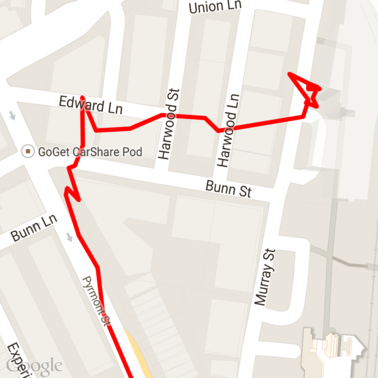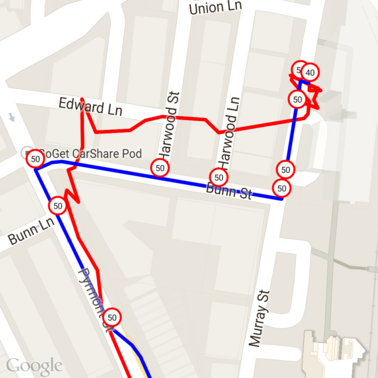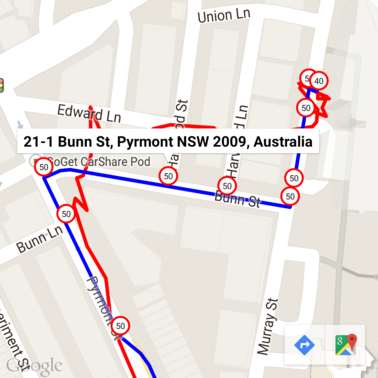กำลังรับข้อมูล
วิธีการรับข้อมูลตำแหน่งที่เก็บรวบรวมไว้มีหลายวิธี เราจะอธิบายเทคนิค 2 อย่างในการดึงข้อมูลเพื่อใช้กับฟีเจอร์สแนปไปยังถนนของ Roads API
GPX
GPX เป็นรูปแบบ XML แบบเปิดสำหรับการแชร์เส้นทาง เส้นทาง และจุดอ้างอิงที่บันทึกโดยอุปกรณ์ GPS ตัวอย่างนี้ใช้โปรแกรมแยกวิเคราะห์ XmlPull ซึ่งเป็นโปรแกรมแยกวิเคราะห์ XML ขนาดเล็กที่ใช้ได้กับทั้งสภาพแวดล้อมเซิร์ฟเวอร์ Java และอุปกรณ์เคลื่อนที่
/**
* Parses the waypoint (wpt tags) data into native objects from a GPX stream.
*/
private List<LatLng> loadGpxData(XmlPullParser parser, InputStream gpxIn)
throws XmlPullParserException, IOException {
// We use a List<> as we need subList for paging later
List<LatLng> latLngs = new ArrayList<>();
parser.setInput(gpxIn, null);
parser.nextTag();
while (parser.next() != XmlPullParser.END_DOCUMENT) {
if (parser.getEventType() != XmlPullParser.START_TAG) {
continue;
}
if (parser.getName().equals("wpt")) {
// Save the discovered latitude/longitude attributes in each <wpt>.
latLngs.add(new LatLng(
Double.valueOf(parser.getAttributeValue(null, "lat")),
Double.valueOf(parser.getAttributeValue(null, "lon"))));
}
// Otherwise, skip irrelevant data
}
return latLngs;
}
นี่คือข้อมูลดิบ GPX ที่โหลดบนแผนที่

บริการตำแหน่งของ Android
วิธีที่ดีที่สุดในการบันทึกข้อมูล GPS จากอุปกรณ์ Android จะแตกต่างกันไปตามกรณีการใช้งาน ดูชั้นเรียนการฝึกอบรมของ Android เกี่ยวกับการรับการอัปเดตตำแหน่ง รวมถึงตัวอย่างตำแหน่งของ Google Play ใน GitHub
การประมวลผลเส้นทางยาว
เนื่องจากฟีเจอร์สแนปไปยังถนนอนุมานตำแหน่งโดยอิงตามเส้นทางทั้งหมด ไม่ใช่จุดใดจุดหนึ่ง คุณจึงต้องระมัดระวังเมื่อประมวลผลเส้นทางยาว (กล่าวคือ เส้นทางที่เกินขีดจำกัด 100 จุดต่อคำขอ)
วิธีพิจารณาว่าคำขอแต่ละรายการเป็นเส้นทางยาวเส้นเดียว คุณควรรวมส่วนที่ทับซ้อนกันไว้เพื่อให้รวมประเด็นสุดท้ายจากคำขอก่อนหน้าไว้เป็นจุดแรกของคำขอที่ตามมา จำนวนคะแนนที่จะรวม จะขึ้นอยู่กับความถูกต้องของข้อมูล คุณควรใส่คะแนนเพิ่ม สำหรับคำขอที่มีความแม่นยำต่ำ
ตัวอย่างนี้ใช้ไคลเอ็นต์ Java สำหรับบริการ Google Maps เพื่อส่งคำขอแบบแบ่งหน้า และจากนั้นกลับเข้าข้อมูลอีกครั้ง รวมถึงค่าที่ประมาณไว้ลงในรายการที่แสดงผล
/**
* Snaps the points to their most likely position on roads using the Roads API.
*/
private List<SnappedPoint> snapToRoads(GeoApiContext context) throws Exception {
List<SnappedPoint> snappedPoints = new ArrayList<>();
int offset = 0;
while (offset < mCapturedLocations.size()) {
// Calculate which points to include in this request. We can't exceed the API's
// maximum and we want to ensure some overlap so the API can infer a good location for
// the first few points in each request.
if (offset > 0) {
offset -= PAGINATION_OVERLAP; // Rewind to include some previous points.
}
int lowerBound = offset;
int upperBound = Math.min(offset + PAGE_SIZE_LIMIT, mCapturedLocations.size());
// Get the data we need for this page.
LatLng[] page = mCapturedLocations
.subList(lowerBound, upperBound)
.toArray(new LatLng[upperBound - lowerBound]);
// Perform the request. Because we have interpolate=true, we will get extra data points
// between our originally requested path. To ensure we can concatenate these points, we
// only start adding once we've hit the first new point (that is, skip the overlap).
SnappedPoint[] points = RoadsApi.snapToRoads(context, true, page).await();
boolean passedOverlap = false;
for (SnappedPoint point : points) {
if (offset == 0 || point.originalIndex >= PAGINATION_OVERLAP - 1) {
passedOverlap = true;
}
if (passedOverlap) {
snappedPoints.add(point);
}
}
offset = upperBound;
}
return snappedPoints;
}
นี่คือข้อมูลจากด้านบนหลังจากเรียกใช้การสแนปไปยังคําขอบนถนน เส้นสีแดงคือข้อมูลดิบ และเส้นสีน้ำเงินคือข้อมูลที่สแนป

การใช้โควต้าอย่างมีประสิทธิภาพ
การตอบกลับคำขอสแนปไปยังถนนจะรวมรายการรหัสสถานที่ที่แมปกับจุดที่คุณระบุไว้ ซึ่งอาจมีจุดเพิ่มเติมหากคุณตั้งค่า interpolate=true
คุณควรค้นหาเฉพาะรหัสสถานที่ที่ไม่ซ้ำในคำขอเท่านั้น เพื่อให้ใช้โควต้าที่ได้รับอนุญาตสำหรับคำขอจำกัดความเร็วได้อย่างมีประสิทธิภาพ ตัวอย่างนี้ใช้ไคลเอ็นต์ Java สำหรับบริการ Google Maps เพื่อค้นหาขีดจำกัดความเร็วจากรายการรหัสสถานที่
/**
* Retrieves speed limits for the previously-snapped points. This method is efficient in terms
* of quota usage as it will only query for unique places.
*
* Note: Speed limit data is only available for requests using an API key enabled for a
* Google Maps APIs Premium Plan license.
*/
private Map<String, SpeedLimit> getSpeedLimits(GeoApiContext context, List<SnappedPoint> points)
throws Exception {
Map<String, SpeedLimit> placeSpeeds = new HashMap<>();
// Pro tip: Save on quota by filtering to unique place IDs.
for (SnappedPoint point : points) {
placeSpeeds.put(point.placeId, null);
}
String[] uniquePlaceIds =
placeSpeeds.keySet().toArray(new String[placeSpeeds.keySet().size()]);
// Loop through the places, one page (API request) at a time.
for (int i = 0; i < uniquePlaceIds.length; i += PAGE_SIZE_LIMIT) {
String[] page = Arrays.copyOfRange(uniquePlaceIds, i,
Math.min(i + PAGE_SIZE_LIMIT, uniquePlaceIds.length));
// Execute!
SpeedLimit[] placeLimits = RoadsApi.speedLimits(context, page).await();
for (SpeedLimit sl : placeLimits) {
placeSpeeds.put(sl.placeId, sl);
}
}
return placeSpeeds;
}
นี่เป็นข้อมูลจากด้านบนซึ่งมีการระบุขีดจำกัดความเร็วไว้ที่รหัสสถานที่ที่ไม่ซ้ำกันแต่ละรหัส

แทรกแซง API อื่นๆ
ข้อดีอย่างหนึ่งของการมีการแสดงรหัสสถานที่ในการตอบสนองสแนปไปยังถนนคือคุณสามารถใช้รหัสสถานที่กับ Google Maps Platform API หลายๆ ตัวได้ ตัวอย่างนี้ใช้ไคลเอ็นต์ Java สำหรับบริการ Google Maps เพื่อเข้ารหัสพิกัดภูมิศาสตร์ของสถานที่ที่ถูกส่งคืนจากคำขอสแนปไปยังถนนด้านบน
/**
* Geocodes a snapped point using the place ID.
*/
private GeocodingResult geocodeSnappedPoint(GeoApiContext context, SnappedPoint point) throws Exception {
GeocodingResult[] results = GeocodingApi.newRequest(context)
.place(point.placeId)
.await();
if (results.length > 0) {
return results[0];
}
return null;
}
ซึ่งเครื่องหมายขีดจำกัดความเร็วได้ใส่คำอธิบายประกอบจากที่อยู่จาก Geoที่อยู่ในรายการ API แล้ว

รหัสตัวอย่าง
ข้อควรพิจารณา
โค้ดสนับสนุนบทความนี้มีให้บริการเป็นแอป Android แอปเดียวที่มีไว้เพื่อการอธิบาย ในทางปฏิบัติ คุณไม่ควรแจกจ่ายคีย์ API ฝั่งเซิร์ฟเวอร์ในแอป Android เนื่องจากคีย์ของคุณไม่สามารถรักษาความปลอดภัยจากการเข้าถึงโดยไม่ได้รับอนุญาตจากบุคคลที่สามได้ เพื่อรักษาความปลอดภัยให้คีย์ของคุณ คุณควรติดตั้งใช้งานโค้ดที่ใช้ API เป็นพร็อกซีฝั่งเซิร์ฟเวอร์ และให้แอป Android ส่งคำขอผ่านพร็อกซีเพื่อตรวจสอบว่าคำขอนั้นได้รับอนุญาต
ดาวน์โหลด
ดาวน์โหลดโค้ดจาก GitHub

